June 2013 – Volume 15, Issue 9: Wind, Solar, Efficiency, and Carbon Neutrality
IN THIS ISSUE
Flanigan’s Eco-Logic
Carbon Neutrality at Colby
Wind Power in the EU
Floating Wind Turbines
Japan Dominates Global Solar
Battery Developments
Campus Conservation Nationals
New Microwave Standards
What’s Up at EcoMotion?

Flanigan’s Eco-Logic: The Bright Side of 400 PPM
Is there anything good about the 400 parts per million milestone? That’s what the Earth’s atmospheric scientists say we have now achieved as a global society. This as record-sized tornados whip Oklahoma. “One of the grimmest measurements,” “a sad milestone,” and at best “a call to action.” Hey, we’re all talking parts per million CO2 in the atmosphere, the predominant greenhouse gas.
Pre-industrial times were marked by 280 PPM CO2. That was before power plants, car, and factories of all kinds. Industrialization and population growth have ratcheted emissions to 400 PPM, with half of the increase in the past 30 years. Since 1995, gases have been rising at an annual rate of 1.9 PPM.
EcoNet takes pride in only reporting good news. So I stretch. Perhaps there is a silver lining to this alarming level, the highest levels since the Pleistocene 2 – 3 million years ago, a time when sea levels were 33 – 66 feet higher. Remember, the IPCC calls 350 PPM the maximum safe level. On May 9th hourly readings atop Mauna Loa were consistently above the 400 PPM mark for the entire day. (Some earlier Arctic readings were above 400 PPM, but not consistently.) So 400 and front-page coverage.
There is good news: Most Americans now believe that the issue is real. Remember, there were deniers upon deniers. (It’s nice to deny it. I certainly wish it were not real.) But so much evidence: The hottest summer on record, prolonged drought, and massive wildfires. Wall Street flooded by Sandy… a “subtropical storm” with a $90 billion price tag. The airlines have reported that flights will be more turbulent. Boulder is considering leaving XCEL Energy to meet its aggressive carbon reduction goals.
The climate change reality is sinking in… and action is the order of the day. NOAA officials claim that, “We have failed miserably in tackling the problem.” That has to change. We are now aware.
Quote of the Week:
“I am particularly proud of the ways our students have engaged with this work. As in other environmental initiatives, they helped provide both the impetus and the research that led to this outcome.”
Carbon Neutrality at Colby
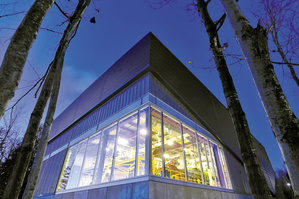
Colby’s biomass plant
Colby College in Waterville, Maine declared its carbon neutrality on April 4th, 2013 becoming one of four U.S. colleges that have claimed this distinction. College of the Atlantic in Bar Harbor, Maine was first in 2007, signing a multi-year contract with the Climate Trust of Oregon for offsets. Green Mountain College in Poultney, Vermont was second in 2011. Butte College has gone carbon neutral without purchasing credits, and is grid positive, sending excess power into the grid.
Colby achieved the distinction by installing a cogeneration facility on campus in 1999, it began purchasing all-green electricity in 2003, and the campus now features eight LEED certified buildings with five others registered. Recently, Colby converted its central heating plant from using nearly a million gallons of #6 heating oil each year to wood chips generally sourced within a 50-mile radius. The campus has invested in comprehensive energy efficiency, included geothermal heating systems in two major construction projects, and spends $50,000 per year for offsets for travel-related emissions. Environmental stewardship is one of Colby’s seven core values.
On and Offshore Wind in the European Union
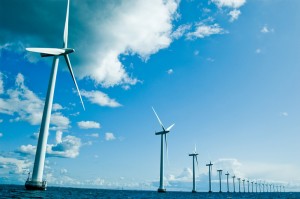
Offshore wind turbines off the coast of Denmark
The European Union has 105.6 GW of installed wind capacity, more than a third of global wind capacity in 2012 of 292,482 MW. (The EU is followed by China with 75,564 MW and the US with 60,007 MW.) Europe’s wind power provides 7% of its total power requirement. Denmark’s wind capacity makes the greatest contribution to its total use (27%), followed by Portugal (17%), Spain (16%), and Ireland (13%).
Of the EU’s total wind capacity, German has 31,332 MW installed followed by Spain (22,796 MW), the United Kingdom (8,445 MW), Italy (8,144 MW), and France (7,564 MW).
Of the EU total, less than 5% is offshore. That said, the EU has been the global leader in offshore developments. At the end of 2012, the installed worldwide offshore wind capacity was more than 5 GW. Of this, 4,993 MW was in European waters, with 400 MW installed in China, and an offshore demonstration facility in Japan. None has been built in America.
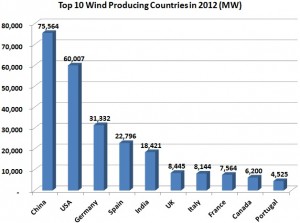 This past year was a big year for offshore wind in the European Union, with 293 offshore turbines installed, bringing the total number of offshore turbines to 1,662 in 55 wind farms located in the offshore waters of ten European countries.
This past year was a big year for offshore wind in the European Union, with 293 offshore turbines installed, bringing the total number of offshore turbines to 1,662 in 55 wind farms located in the offshore waters of ten European countries.
The U.K. has by far the greatest offshore wind activity. Of the EU’s 4,993 MW of offshore capacity, 2,948 MW or just shy of 60% is in the U.K., and mostly in the North Sea. The U.K. is followed by Belgium 16%, German 7%, and Denmark 4%.
Floating Wind Turbines from Maine
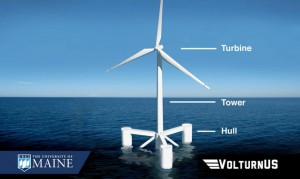 In related news, the University of Maine has been researching floating wind turbines. Supported by $12 million over five years from the U.S. Department of Energy, on May 31st researchers of the Castine Wind Project deployed the 65-foot high, 20 kW VolturnUS, a one-eighth replica of planned 6 MW floating turbines. Launched in Brewster, VolturnUS will be anchored offshore and will be the nation’s first grid-connected offshore wind turbine.
In related news, the University of Maine has been researching floating wind turbines. Supported by $12 million over five years from the U.S. Department of Energy, on May 31st researchers of the Castine Wind Project deployed the 65-foot high, 20 kW VolturnUS, a one-eighth replica of planned 6 MW floating turbines. Launched in Brewster, VolturnUS will be anchored offshore and will be the nation’s first grid-connected offshore wind turbine.
Its developers note that onshore wind is usually strong at night, when the utilities least need it. Offshore wind is consistent in late afternoon, when predictable strong breezes pick up and when power is most needed. DOE is funding the project through its Office of Wind and Water Power Technologies, a $168 million program supporting three floating wind projects (of which this is the first), and four fixed offshore wind projects. DOE’s project goal is to support the development of $0.10/kWh offshore wind power.
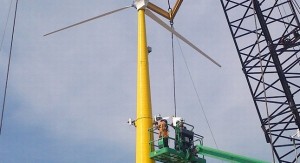
Workers prepare for launch
Offshore wind is estimated to be able to provide 4,000 GW of renewable power in the United States, four times current national electricity consumption. In Maine, as with many areas, the bulk of its 156 GW offshore wind potential is in deeper waters, inaccessible for fixed turbine towers. Maine has a goal of harvesting 5 GW of this capacity by 2030, creating a $20 billion infusion into its economy.
To capture this potential, floating turbines make sense. Thus a semi-submersible, concrete-composite floating platform (also a first) was developed by the University of Maine Advanced Structures and Composites Center. The unique, semi-submersible platform uses a lower-cost concrete foundation and a lighter-weight composite tower. The wind turbine tower is mounted on top of three concrete tubes, anchored like an oil platform.
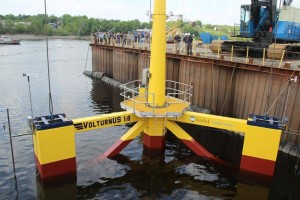
Up-close look at the hull
Japan Dominates Global Solar
 Step aside Germany and China! Spain and Italy’s rise in solar prominence is now old hat.
Step aside Germany and China! Spain and Italy’s rise in solar prominence is now old hat.
Japan is poised to be the largest solar market – by revenues – in 2013, soaring past #2 China which will likely take the #1 installed capacity distinction this year. Germany is still way out front in installed capacity. Fukushima has a lot to do with it. Following the earthquake and tsunami that resulted in nuclear disaster in March of 2011, Japan took steps to introduce incentives that reward renewables… big time. In June of 2012, Feed-in Tariff (FiT) incentives were introduced with the best prices for small-scale wind turbines at 57.8 yen/kWh (~57 cents); large and small solar was awarded 53 cents/kWh.
Despite the runaway growth in Japan, experts point to program design pitfalls. As with most FiT programs, by Japanese law, incentives prices must be revised each business year. This causes investor uncertainty. This year incentives for rooftop solar dropped down to 38 yen (~38 cents) per year for rooftop solar less than 10 kW; to 36 yen for larger systems. Note also that big systems get 20-year contracts, little ones only 10 years. This makes little sense but given strong residential uptake, program designers are not likely to extend the term.
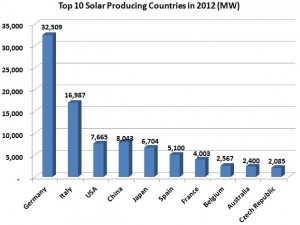 Recently the Japanese Ministry of Economy, Trade, and Industry began offering low-interest loans to solar companies that lease residential rooftops, with homeowners getting 10,000 – 20,000 yen each year (~$100 – 200) for the use of their roof space.
Recently the Japanese Ministry of Economy, Trade, and Industry began offering low-interest loans to solar companies that lease residential rooftops, with homeowners getting 10,000 – 20,000 yen each year (~$100 – 200) for the use of their roof space.
Japan’s solar surged 270% in the first quarter of 2013, with 1.5 GW of installations. (European installations dropped by 34% in this same time period.) And given deceleration of the solar market in Europe, Japan’s share of the global solar market revenues will likely rise to 24%.
Barriers to entry in Japan include: Strict certification requirements, particularly for inverters, and strong preference for Japanese brands. Another market barrier: Projects must have a master electrician on site at all times during construction. How about finding locations for solar in Japan? The law does not allow developers to put solar systems on agricultural lands, a limiting issue also faced in Italy.

Battery Developments – Firming up Intermittent Renewables

PG&E’s 4 MW battery bank
A ribbon-cutting, and some words no doubt on the profound value of storage technology to back up intermittent renewables. The hosts, PG&E and the CEC; the location, the HGST facility in east San Jose for the official launch of the Yerba Buena Battery Storage Pilot Project.
The battery energy storage system is designed to accommodate for excess and deficit periods of power capacity. The system charges batteries when demand is low and then sends stored power to the grid when demand grows. The system has the potential to balance energy supply and demand, helping to support greater integration of intermittent renewable generation, as well as improving power quality and reliability for customers.
The battery in focus is sodium-sulfur with a 4-megawatt capacity. It can store more than six hours of energy. The project was made possible thanks to a $3.3 million grant from the California Energy Commission to PG&E that will support the installation and evaluation of the system.
There is considerable activity in the battery space domestically and in Europe. A survey by IMS Research with respondents from Germany, Italy, and the United Kingdom found that energy storage was rated more critical than any other requirement for future inverters.
Respondents suggested that 40% of PV systems in their target areas will be backed up by 2015. And what is an acceptable premium? The survey found 10 -29% was anticipated and acceptable. In May, and as part of a new $30 million initiative, Germany began providing incentives for homeowners with solar systems to add battery backup.
Senators Ron Wyden (D-OR) and Susan Collins (R-ME) have teamed up again to introduce a bill in Washington to promote energy storage, specifically electricity storage to cover peak periods. The bill provides a 30% investment tax credit for businesses that install storage technologies; the same tax credit is extended to homeowners. A 20% tax credit – up to $40 million per project – is also slated for grid-scale storage systems.
Bill Gates and other investors see the value of the energy storage market too and have recently invested $35 million in Aquion Energy, a company developing water-based battery system for large and small-scale energy storage to supplement the grid. In these batteries, the anode is made of carbon, the cathode made of sodium and magnesium oxide, and a water-based electrolyte. Aquion batteries can hold charges for 2 – 6 hours, and can endure 5,000+ charging cycles. The company plans factories that will produce batteries capable of storing 500 MWh in 2013 and 2014.
Meanwhile, Bill Gates’ friend Warren Buffet is lighting up the press with Berkshire Hathaway’s MidAmerican Energy Holdings buying Nevada’s largest utility, NV Energy, for $5.9 billion. The Las Vegas-based utility has 8.4 million customers. In contrast to the high-tech Bill Gates, the 82-year old Buffet is the master of investments in basics like socks, candies, and soda. He has commented in the past on the “attractive fundamentals of regulated utilities,” with earnings power even under adverse conditions. Buffet has long stated that owning utilities is not a good way to get rich, but a good way to stay rich!
Campus Conservation Nationals 2013
 The fourth year of the Campus Conservation Nationals was a marked success, with results from the energy-saving competition exceeding projections. The Nationals are organized by the Alliance to Save Energy, the National Wildlife Federation, the Center for Green Schools a the U.S. Green Building Council, and the Lucid Design Group which provides its “Energy Dashboard” systems to participating colleges at no cost to track results. This year, 150 schools and 250,000 students were involved.
The fourth year of the Campus Conservation Nationals was a marked success, with results from the energy-saving competition exceeding projections. The Nationals are organized by the Alliance to Save Energy, the National Wildlife Federation, the Center for Green Schools a the U.S. Green Building Council, and the Lucid Design Group which provides its “Energy Dashboard” systems to participating colleges at no cost to track results. This year, 150 schools and 250,000 students were involved.
The competition began in 2010 with 12,000 students achieving savings of 500,000 kWh. Last year, the savings grew to 1,739,046 kWh worth about $160,000. This year, from February 6 – April 6, 2,114,844 kWh were saved, the equivalent of taking 187 houses off the grid for a year. Additionally, the students saved 1,681,241 gallons of water, equivalent to 11,208 shower hours!
Top schools for energy savings: Oregon State University, Harvey Mudd, St. John’s, and Northwest Missouri State. In addition to participating in the Campus Conservation Nationals, California has its own “league” thanks to the PowerSaver Green Campus Program run by the Alliance to Save Energy. Chico State reduced energy use by 12.8% during the competition thanks to all sorts of student activities included “energy efficiency trivia nights” in the residence halls. U.C. Merced has been awarded two years in a row, with documented 8.2% average dorm room savings. Winning institutions are awarded carbon offsets. NWF has embellished the competition with a video contest so that students can use their experiences to inspire others.
Efficiency Standards for Microwaves
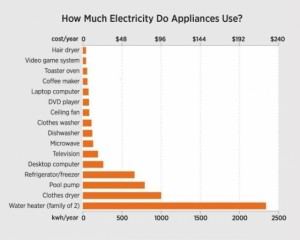 The U.S. Department of Energy has finalized new energy efficiency standards for microwave ovens. The standards for microwave ovens will reduce energy consumption in standby mode by 75% in countertop microwave ovens and over-the-range microwave ovens without convection features, and by 51% for over-the-range microwave ovens with convection, preventing 38 million metric tons of carbon pollution over the next three decades. These standards will go into effect starting in 2016. The American Council for an Energy-Efficient Economy reports that microwaves are typically in use for 70 hours a year, and standing by for the remaining 8,690 hours, continually drawing up to 4 watts of vampire power.
The U.S. Department of Energy has finalized new energy efficiency standards for microwave ovens. The standards for microwave ovens will reduce energy consumption in standby mode by 75% in countertop microwave ovens and over-the-range microwave ovens without convection features, and by 51% for over-the-range microwave ovens with convection, preventing 38 million metric tons of carbon pollution over the next three decades. These standards will go into effect starting in 2016. The American Council for an Energy-Efficient Economy reports that microwaves are typically in use for 70 hours a year, and standing by for the remaining 8,690 hours, continually drawing up to 4 watts of vampire power.
What’s Up at EcoMotion?

LA Metro’s maintenance divisions are ripe for solar
In May, EcoMotion delivered final sets of “Green for Life” reports for the cities of Palm Springs, Indian Wells, Rancho Mirage, Blythe, Desert Hot Springs, and Cathedral City, and the Agua Caliente Tribe of Cahuilla Indians in the California’s gorgeous Coachella Valley. Thanks to hundreds of engaged local government officials and stakeholders for being involved in this process. Thanks also to Aliana Lungo, Virginia Nicols, Russ Flanigan, Jordan Garbayo, and Maria Jauregui, and to our visiting consultants Ralph Torrie, Rick Heede, and Pat Conlon.
Each set of climate action planning documents prepares the jurisdiction for regulatory compliance and includes a 2013 Greenhouse Gas Inventory (each with 100 pages of custom methodological briefings), a 2013 Climate Action Plan to guide the entire community, and a 2013 Energy Action Plan to cut costs in municipal operations and fleets through energy efficiency.
The EcoMotion Solar Team has been managing a competitive solicitation for a 1.6 MW photovoltaic system on behalf of a campus client in New York State. With TRC Engineering, the team has also just completed the first phase of a Renewable Energy Dashboard for LA Metro, a tool that will align hundreds of Metro properties with shifting rate offsets in multiple utility territories. Thanks to Michael Ware and Drew Lowell-Britt for spearheading this work.
In other news, in collaboration with Anaheim Public Utilities EcoMotion is siting Solar Flags at elementary schools. The new online permitting system that we are managing for the City of Brea is near live, as is the utility manager software system there that EcoMotion has facilitated with Los Angeles County. This tool will allow Brea online access to energy use at all of its municipal facilities and meters.
EcoMotion is hiring: On the West Coast, applications have been received for a senior position as Director of Business Development. On the East Coast, EcoMotion is seeking a Campus Sustainability Associate.
